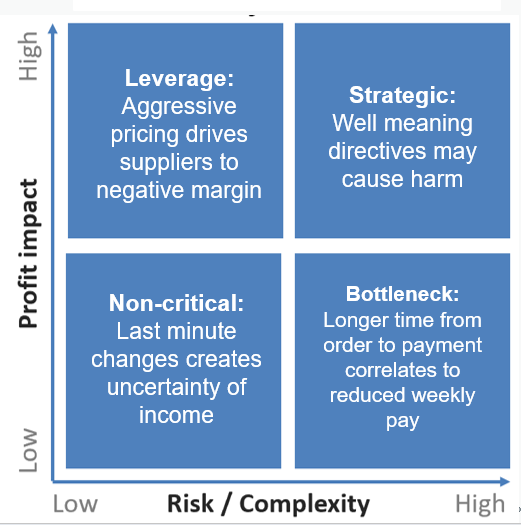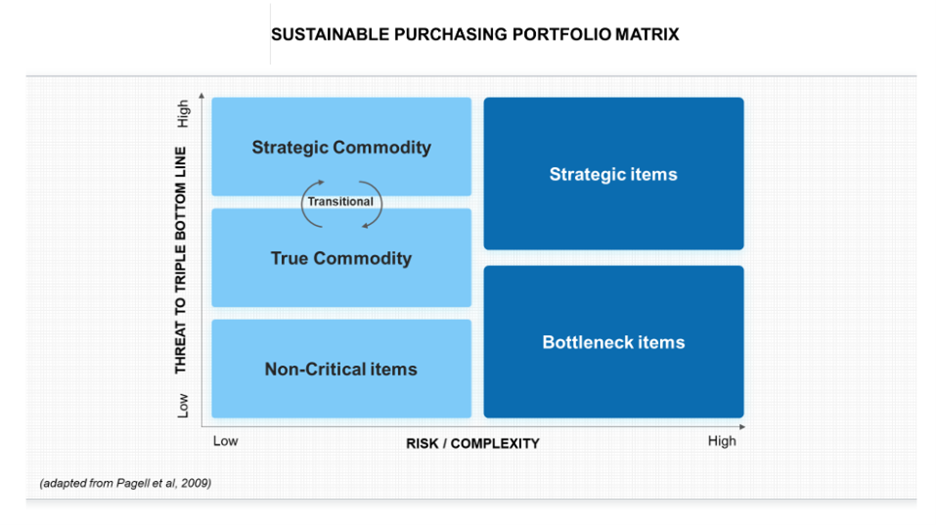
Is the Kraljic Model of Procurement Broken?
- The 2x2 model proposed in 1983 has become the de-facto strategic decision-making tool on how to manage supplier interactions.
- Yet many procurement teams continue to misunderstand and misapply the model.
- The sustainable procurement portfolio model proposed by Pagell et al. addressed many of the deficiencies in Kraljic but is not widely known.
April 10, 2023 | Procurement Strategy 4 minutes read
It has been 40 years since management consultant Peter Kraljic published his seminal paper in the Harvard Business Review. Since then, the 2x2 Kraljic matrix or model has become the de-facto strategic decision-making tool on how to manage supplier interactions. The model has been a key contributor to turning procurement into a strategic business contributor.
How times have changed. On re-reading today, it refers to high technology using the example of a 256K RAM chip, for example! But also, the priorities and scope of category management has shifted, and the model is creaking under the weight of 2020s priorities.
Also read: How a New CPO Can Pick the Right Savings Transformation Flavor
Applying the Kraljic Model: A Mixed Report Card
The models in the paper have been widely misapplied and misunderstood.
- Procurement teams mostly apply with some success "Phase 1: Classification" using the eponymous 2x2 matrix (Bottleneck, Leverage, etc.). The phase is criticized for being too subjective but it’s easy to apply and therefore widely disseminated. Subjectivity leads to a bias where category managers overstate the profit impact and risk dimensions in their analysis. After all, who wants to be managing non-strategic categories?
- A large minority of teams do not apply "Phase 2: Market Analysis" which is a useful portfolio analysis matrix. It’s a well-known model (Nuisance, Exploit etc) but not always used.
- Few procurement teams apply “Phase 3: Strategic Positioning," which is the final model on how to treat strategic suppliers.
Is It Time for a Change?
There have been many critiques of the Kraljic model, not the least Kraljic himself, who wished the concept of collaboration was more prominent in the paper.
It does not capture the concept of networks, the interdependencies between products or the concern for sustainability1.
Andrew Cox, professor emeritus of the International Institute for Advanced Purchasing & Supply, said that the Kraljic model "does not provide us with any proactive thinking about what can or should be done to change the existing reality of power.2"
Also read: Deciding When To Build or When To Buy a Procurement Function (Or Parts)
The Negative Impact of Decision-making Based on Kraljic
With the growing awareness of modern slavery in supply chains, it’s become clear that procurement actions matter. Applying too vigorously one approach based on Kraljic increases the risk of workforce exploitation as shown below.

Leverage: Higher risk of labour exploitation if suppliers face negative margins
Non-Critical Items: Last-minute changes to orders or requirements equals higher risk of workers not getting paid
Bottleneck: Longer payment terms and extended order-to-payment lifecycle are shown to reduce weekly pay level
Strategic: Imposing well-meaning but typically western solutions and values through various policies and directives may actually damage the workers and their families overall income.
So over-zealous application of Kraljic could cause harm. And furthermore, something started to show up in research. Was Kraljic becoming broken?
"During the analysis of data collected as part of a study on exemplars in Strategic Supply Chain Management (SSCM), a significant anomaly emerged related to the well-established purchasing portfolio framework. We observed that a number of leaders in SSCM were not making purchasing decisions in the manner suggested by Kraljic (1983) nor were these firms acting in ways that alternative approaches would completely predict, 3" says a paper by Mark Pagell, Zhaohui Wu and Michael E. Wasserman.
The main revelation is that buying firms are not leveraging their commodity purchases in particular circumstances. These include business continuity and sustainability risks.
Instead, benevolent suppliers are seeking common prosperity with some suppliers in the hope of improving long-term market conditions to help lift employees out of impoverishment and improve the environmental impact of its supply base on the local communities it works in.
In short, the Kraljic model no longer works in the 'Leverage' quadrant in commodity markets that are environmental or social risk. These leverage commodities need to be treated as strategic when the triple bottom line impact is threatened.
Pagell et al. therefore have proposed a variant of Kraljic.

The key variations are:
1. The Y-axis is sensibly expanded to become "Threat to Triple Bottom Line"
2. The removal of leverage items into three commodity types:
- (a) True commodities that are treated as per the Kraljic model leverage definitions
- (b) Strategic Commodities are those critical commodities that transcend traditional economic considerations. For example, energy, primary raw materials for an energy firm, food ingredients for a food manufacturer etc.
- (c) Transitional Commodities that may receive temporary status as 'strategic' in order to raise overall standards, well-being and sustainability goals before returning to a more traditional True Commodity status when supply market standards confidently meet the buyer goals.
Whilst this revised model by Pagell et al. was released in 2009, and is widely cited by scholars, it remains relatively unknown amongst practitioners.
This paper, now 15 years old, was ahead of its time, but now, with significant sustainability commitments mandated or committed to by organizations, it’s time to think again and harder about our flawed modeling of purchasing and supply dynamics.
“An attitude of ‘purchasing as usual’ will make the company vulnerable to competitive pressure; but enhanced strategic awareness, greater flexibility, and stronger entrepreneurial thinking in the supply area can improve the supply security and lower the input costs of any company.”
Krajlic had closed his HBR paper4 with these words as a clarion call to action. They still ring true 40 years later.
1 [1] Geldeman & Weele, Purchasing Portfolio Models: A Critique and Update, Literature Review, 2005
2 Cox, A. Business Success — A Way of Thin king about Strategic, Critical Supply Chain Assets and Operational Best Practice, Earlsgate Press, Great Britain, 1997
3 Pagell, M et al. "Thinking Differently About Purchasing Portfolios: An Assessment Of Sustainable Sourcing", Journal of Supply Management, 2009
4 Peter Kraljic, “Purchasing Must Become Supply Management”, Harvard Business Review, 1983
Turn ideas into action. Talk to GEP.
GEP helps enterprise procurement and supply chain teams at hundreds of Fortune 500 and Global 2000 companies rapidly achieve more efficient, more effective operations, with greater reach, improved performance, and increased impact. To learn more about how we can help you, contact us today.

Graham Copeland
Senior Director- Business Development
Graham leads business development of the services organization for the UKI region. He has 25 years of procurement and sales leadership experience and has worked as an employee and a consultant with Schlumberger, Coop Group, Tesco Bank, BP, ABN Amro and Deutsche Bank. At GEP, he helps CPOs with operating model decisions and procurement transformations. He also runs the Proctopus procurement community. Graham holds a Bachelor’s degree in engineering and business from The University of Strathclyde.



